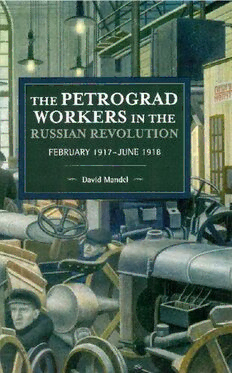Table Of ContentThe Petrograd Workers
in the Russian Revolution
Historical Materialism Book Series
T
he Historical Materialism Book Series is a major publishing initiative of
the radical left. The capitalist crisis of the twenty-first century has been met
by a resurgence of interest in critical Marxist theory. At the same time, the
publishing institutions committed to Marxism have contracted markedly since
the high point of the 1970s. The Historical Materialism Book Series is dedicated
to addressing this situation by making available important works of Marxist
theory. The aim of the series is to publish important theoretical contributions as
the basis for vigorous intellectual debate and exchange on the left.
The peer-reviewed series publishes original monographs, translated texts,
and reprints of classics across the bounds of academic disciplinary agendas
and across the divisions of the left. The series is particularly concerned to
encourage the internationalization of Marxist debate and aims to translate
significant studies from beyond the English-speaking world.
For a full list of titles in the Historical Materialism Book Series
available in paperback from Haymarket Books, visit:
https: //www.haymarketbooks.org/ series_collections/ 1-historical-materialism
The Petrograd Workers
in the Russian Revolution
February 1917-]une 1918
David Mandel
Haymarket Books
Chicago, IL
First published in 2017 by Brill Academic Publishers, The Netherlands
© 2017 Koninklijke Brill NV, Leiden, The Netherlands
Published in paperback in 2018 by
Haymarket Books
P.O. Box 180165
Chicago, IL 60618
773-583-7884
www.haymarketbooks.org
ISBN: 978-1-60846-006-9
Trade distribution:
In the US, Consortium Book Sales, www.cbsd.com
In Canada, Publishers Group Canada, www.pgcbooks.ca
In the UK, Turnaround Publisher Services, www.turnaround-uk.com
All other countries, Ingram Publisher Services International, ips_intlsales@
ingramcontent.com
Cover design by Jamie Kerry and Ragina Johnson.
This book was published with the generous support of Lannan Foundation
and the Wallace Action Fund.
Printed in the United States.
10 9 8 7 6 5 4 3 2 1
Library of Congress Cataloging-in-Publication data is available.
To the memories of
Leopold H. Haimson (1 927-2010)
my teacher and defender
Ivan Kupriyanovich Naumov (1 895-1938)
Vyborg district worker, Bolshevik, Left Oppositionist to Stalinism
••
Contents
List of Tables and Maps XI
Glossary XIII
Introduction 1
1 Types of Political Culture in the Industrial Working Class of
Petrograd 9
Skilled Workers 9
Unskilled Workers 26
The 'Worker Aristocracy' 38
The Generational Factor 46
2 The Social Composition of the Industrial Working Class of Petrograd
and its Districts 52
The Social Composition of Petrograd's Districts 57
The Vyborg District 6i
Petergof and Narva Districts 64
Vasilevskii ostrov 65
Petrograd District 66
Moskovskaya zastava 67
Nevskii-Obukhovskii District 68
Kolomna District 68
Second City District 69
First City District 69
Rozhdestvenskii District 69
Okhta and Porokhovskii Districts 70
3 The Honeymoon Period - From the February to the April Days 71
The Labour Movement during the War 72
The February Revolution - The Birth of Dual Power 74
Attitudes Regarding State Power and the Relationship to Census
Society 77
Dual Power in the Light of Attitudes before the Revolution 87
Why Dual Power? 95
VIII CONTENTS
4 The February Revolution in the Factories 102
The Eight-Hour Day 103
Wages 107
The Press Campaign against 'Worker Egoism' 112
Worker-Management Relations: 'Democratisation of Factory
Life' 115
Purge of the Factory Administrations 117
The Factory Committees 121
5 From the April to the July Days 133
The April Days 133
The First Coalition Government 145
The Break with Census Society 148
The Underlying Causes of the Shift to Soviet Power 155
The Spectre of Counterrevolution 155
The 18june Military Offensive 162
Economic Regulation 165
6 The Struggle for Power in the Factories in April-June 182
7 The July Days 193
The Workers and the Menshevik-sR Soviet Majority 193
TheJulyDays 197
Reaction Unleashed 204
8 Rethinking the Revolution: Revolutionary Democracy or Proletarian
Dictatorship? 217
Census Society on the Offensive 217
Final Rejection of 'Conciliationism' 226
The Question of 'Revolutionary Democracy' 239
9 From the Komilov Uprising to the Eve of October 254
The Kornilov Uprising 254
The Democratic Conference 265
Setting Course for Soviet Power 274
10 Class Struggle in the Factories - September-October 279
The Factory Committees under Attack 279
The Struggle for Production - Workers' Control Checked 281
From Workers' Control towards Workers' Management 290
CONTENTS IX
Factory Committees under Pressure 'from Below' 293
The Struggle for Production and the Question of State Power 300
Quiet on the Wage Front 303
11 On the Eve 307
12 The October Revolution and the End of 'Revolutionary
Democracy' 331
Workers' Attitudes towards the Insurrection 334
The Question of a 'Homogeneous Socialist Government' 348
Unity from Below 365
13 The Constituent Assembly and the Emergence of a Worker
Opposition 371
The Elections 371
Dissolution of the Constituent Assembly 380
The Chernorabochie and the Upsurge of Anarchist Influence 388
The Lines Harden 393
14 The October Revolution in the Factories 398
'Active' or 'Passive' Control? 398
Towards Nationalisation 412
Management in Nationalised Enterprises 420
15 Summon Up Every Last Ounce of Strength or Accept Defeat! 428
Dispersal of Petrograd's Working Class 428
The 'Obscene Peace' 434
The Rise and Failure of the Opposition 440
Conclusion 474
Bibliography 485
Index of Names and Subjects 494

